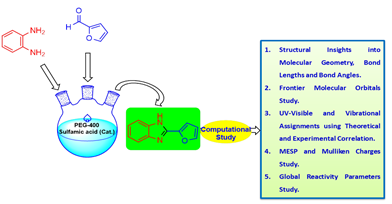Computational Chemistry: Sulfamic Acid Catalyzed PEG-400 Mediated Synthesis, Molecular Structure, HOMO–LUMO, UV-visible, Vibrational, and Reactivity Descriptors Analysis of 2-(Furan-2-yl)-1H-benzo[d]imidazole

- DFT; 2-(Furan-2-yl)-1H-benzo[d]imidazole; HOMO-LUMO; Molecular electrostatic surface potential
Copyright (c) 2021 Orbital: The Electronic Journal of Chemistry

This work is licensed under a Creative Commons Attribution-NonCommercial-NoDerivatives 4.0 International License.
Abstract
2-(Furan-2-yl)-1H-benzo[d]imidazole (2-FBI) is synthesized and investigated using computational chemistry in the present analysis. PEG-400 and catalytic amount of sulfamic acid presents green protocol for the synthesis of 2-FBI. FT-IR, 1H NMR, and 13C NMR spectroscopic methods were used to characterize the structure of 2-FBI. The density functional theory (DFT) approach was used to perform the theoretical calculations, with a basis set of 6-311++G(d,p). Theoretical and experimental UV-Visible investigation is correlated to obtain better insights into the absorption spectral studies. The experimental vibrational frequencies were compared with the scaled vibrational frequencies for the assignment of vibrational bands. Molecular electrostatic surface potential and Mulliken atomic charges are employed for the determination of charge density and reactive sites. In addition, the more precise computation of Mulliken atomic charges is done by comparing 6-311++G(d,p) and 6-311G(d,p) basis sets.
